The Very Small Container Garden Series Part 3: Choosing Your Plant Palette
A start-up series for urban and small space containers gardens.
An echinacea growing in a container bringing joy.
I walked into my local garden center recently and saw a giant sign heralding spring and the start of the new gardening season. At the front, near the bird seed and pet treats, was a promotional advertisement with their new offer for the spring season. In large bold lettering it promised:
Let us take the guesswork out of gardening!
Winning combinations to fill your summer with color!
Delivery available!
That's right, they were offering a Plant-by-Numbers kit that could be delivered straight to my door. I was impressed at their acumen for anticipating many gardeners' biggest fears: choosing the wrong plants and failure. No doubt there are a lot of people who will jump at the offer and breathe a sigh of relief at having all the work taken out of starting their garden.
If Plant-by-Numbers kits are the ticket to getting more people into gardening, then I can totally get on board with the offer. If that's what you're looking for here, then I will leave you disappointed.
There are too many variables - contextual, geographic and human - to make planting recommendations that will suit every garden and gardener. Very small container gardens, by nature, are wildly variable in their situation - urban, balcony, rooftop, patio. Your plant palette will vary accordingly. To me, plant selection is where the magic first happens - the transformation of yard work into gardening. Gardening is a creative practice, and you are the master artist.
Gardening is a creative practice, and you are the master artist.
My goal in this series is to suggest an approach to small container gardening that will help you express your creativity while also setting you up for success.
Ready to dive in? Let's go.
And the Gardener Said "Let There Be Soil"
Starting a container garden is kind of like playing God in your own little patch of the world. You are putting a garden in a place it doesn't exist on it's own and bringing in living plants to situations they haven't chosen of their own accord. You choose a container, you add soil and then you add plants. Ta-Da! You've created a microcosm of the world on your balcony.
With your new god-like powers, choose wisely. With great power comes great responsibility, as they say.
To get to this point in planning your container garden, you have probably already made some important decisions:
You have assessed your garden's aspect, exposure to wind and weather, and context (e.g., sunlight, water source, nearby buildings, overhangs, etc.)
You have selected containers, and know what size and depth they will be (or at least have a plan to guide your plant selection if you are building your garden container by container).
Next, you need to select your soil.
But, I'm here to learn about plants and gardening in pots! What's all this about soil??
Stay with me on this. Soil is the foundation for all successful planting. If you want a lush, bountiful garden, then getting the soil right is important. I'm not going to do a deep dive into soil biology right now. Whole books have been written on the subject. Here's a quick overview to get started:
Soil varies in its composition and different soils have different ingredients. Like a cake, each ingredient plays an important role in keeping your plants happy and healthy. It’s a mix of minerals (like sand, silt, and clay), organic matter (such as decomposed leaves and tiny organisms), water, and air. The balance of these components determines how well soil holds moisture, drains excess water, and provides nutrients for plant roots.
For example, sandy soil drains quickly but doesn’t hold nutrients well, while clay soil holds lots of water but can get compacted. The best soil, often called loam, has a mix of everything—giving plants just the right blend of nutrients, air, and moisture to thrive. If you garden in the ground, then you will want to understand whether your soil is sandy, clay or loam.
Right now, as you're starting your container garden, it's just important to understand the fundamentals. Much of the soil science has been done for you. I'd argue that this is one of the reasons why container gardening can feel so much more successful than growing in the ground - there's a level of control right out of the gates.
But, it's not hard to do. Here are a few considerations at this point:
Start with a potting soil mix: Container gardening requires a soil mix that is different than top soil or what you find in the ground. Garden centers often have a few different potting soil options. Choose the highest quality potting mix you can afford. But, there's no need to overthink it at this point. Look at the ingredients list on the bag and make sure it has some combination of worm castings (worm poop - not smelly at all, promise), organic compost, and perlite (for drainage). There may be other ingredients in there too, but these three are the ones to look out for. Avoid using peat if you can (though options are often limited). Choose organic soil, especially if you will be growing things to eat. It will be more expensive, but spring for it if you can - it will be more productive for you and better for the planet too.
Consider drainage and plan accordingly: Plants are like people - they have all different preferences and personalities. Some thrive with lots of water, others like it dry. Some are picky and like to be damp, but want to keep their feet dry. As the gardener, you have the power to create the conditions they need to thrive. This is where soil drainage is important. Since containers dry out faster than the in-ground garden beds, potting mixes are crafted to retain moisture a bit longer. However, it's important they don't drown your plants, so there's often perlite added to balance moisture retention and keep it from becoming waterlogged. Perlite is the white stuff you see floating in your potting mix.
Some plants need more drainage to thrive. Adding extra perlite to your potting mix may be very helpful to keep them happy. You can also add sand to your mix to have a similar effect. In the UK they have products called "horticultural grit" and "sharp sand" that they often add to improve drainage. We don't have these products in the U.S. "Builders sand" is a rough equivalent, but you probably won't need to find it unless you decide to grow a huge number of succulents or cacti (you can also just buy a cactus soil mix).
Pay attention to the drainage needs of your plants when you choose them: If the plant tag indicates that the plant needs excellent drainage, then consider adding perlite or sand. You don't have to do it, but it can be helpful. If you don't, then you'll need to be especially careful about your watering and ensure the container isn't sitting in water.
Now for the Fun Part: Selecting your Plant Palette
As we jump into discussions about plants for your garden, I feel strongly that I need to set a foundational rule for you as a gardener: You get to plant whatever makes you happy and sparks joy for you. That's it. That's the only rule you need to follow. Plants - like any trend out there - go in and out of fashion. Colors and leaf forms even have seasons of popularity! In your garden you are the artist, the creator, the cultivator. Play with it and plant what you love.
Foundational Rule for Gardeners: You get to plant whatever makes you happy and sparks joy for you.
However, as mentioned above, plants are like people, and they have preferences about soil, drainage and what size pot they will thrive in. In The Very Small Container Garden Part 2: Choosing Your Containers I went into detail about planting depths for a variety of plants - check it out if you want to get a sense of depth requirements and container selections.
You can also plant multiple plants into a shared container, if it's big enough. This has a few potential benefits for your very small container garden:
It can help you maximize your growing possibilities in a tight space.
It gives you the opportunity to make beautiful plant combinations that are interesting to look at - a particularly valuable trait if your balcony or patio is very small and you only have so many things to look at as you sip your morning coffee.
The key with combination plantings is to make sure that your container is big enough (depth and width) to be able to accommodate them all. To give yourself the best chances of success with your mixed containers, choose plants that have similar water and light requirements (check the plant tags for requirements). Fertilizing will be important, and this will be covered in Part 4 of this series.
A well-used design guideline for mixed planters is to choose a Pillar, a Filler, and a Spiller in your pots:
Pillar - sometimes also called the "Thriller" is a taller plant that is the real eye catcher in the mix, and that is often planted in the center of the pot.
Filler - a plant that has a mounding growing habit that fills space in the pot and is shorter than the pillar/thriller plant.
Spiller - a plant that grows over the edge of a pot and cascades down the sides in an attractive way.
You don't have to follow these guidelines, but they can be a good place to get started creatively.
A street planting spotted in Rockford, Illinois that clearly shows the pillar-filler-spiller concept in action. Scale up and down depending on your space and container size.
So Many Choices?! Which Plants to Choose??
Walking into a garden center and selecting plants can be super fun, but it can also be overwhelming. Generally, plants will be grouped according to their lifecycle and it's good to keep this in mind as you make your choices:
Annuals - live their entire lives in one growing season. They germinate from seed, grow, produces flowers, set seed and die in one year. They will die no matter how well you treat them. It's not personal - it's just how they are. They are the fastest to grow and usually the showiest in terms of flowers and fruit. They are low commitment in terms of time.
**If you are a renter or have a very small space, you may find that annuals give you the most wow factor for your money and time in place.
Perennials - live for more that one year and will give you the best value for your money at the outset. They tend to grow more slowly than annuals, and sometimes flower or set fruit in their second year. Most nurseries will sell you plants in bloom (higher sales margin for them) so you probably won't have to wait for flowering. Having a perennial or two in your container garden can provide interest over a longer time and will be lower maintenance than annuals. They can keep it looking green and alive while the annuals cycle through their flowering.
*If you are a renter or plant to move soon, then you will want to consider moving your perennials with you as you relocate.
Biennials - are less common in nurseries, but include a lot of gorgeous plants. That's because they split the difference between annuals and perennials - they require two seasons to grow and then they die. Biennials will germinate and grow in one season, then overwinter and return to flower and set seed the next. This can feel very slow in a container garden that is on view all the time. You can buy biennials in flower and treat them like annuals if you want to have them in your garden, but don't want to wait over multiple seasons.
Beauty and the Bees: Planting to Sustain Life (both human and wild)
I assert that gardens are essential to sustaining life on this planet we share - human and non-human alike. Even very small gardens make a huge difference. (And I'm not just talking about plants we can eat - more on that later). As you choose your plants, here are a few perspectives to consider that may help you design your garden:
Plant for wildlife (even on an urban balcony or rooftop) - we aren't the only ones who will benefit from our gardens. Birds, bees, butterflies, insects and small mammals love our gardens too. This isn't a bad thing - they pollinate your plants to ensure your flowers and fruit grow. While I'm not advocating that you attract pests to your garden on purpose, I am suggesting that choosing your plants to be beneficial to wildlife is a bonus. Choose plants with varying flower shapes that are attractive to pollinators (e.g., umbels, tubes, open daisy shapes, etc.). It doesn't take much to bring some excitement to you garden.
I planted one red salvia on my balcony one summer and I had a visit from a hummingbird every morning while drinking my coffee. (Hummingbirds apparently really like red flowers).
Cultivate beauty for your soul - choose plants that feed your senses and make you happy. Choose colors that you love to look at. Add fragrance to your garden to give yourself some at-home aromatherapy. Find textured plants that invite you to touch and interact with them. Your garden is your place to cultivate for yourself. With so many of us living in cities, creating a small place of our own to quiet our minds, breathe, get vitamin D and soak in some nature is hugely important to our health and well-being. Don't discount the positive impacts that the smallest of gardens can provide! You don't have to take my word for it; there's a ton of scientific research to support this. You'd be surprised how much difference tending a single container with flowers or edible plants can make on your well-being.
Focus on foliage for the win - don't forget that green is a color too. This can be an especially helpful reminder for those of us with shady spaces who feel limited in our colorful flower choices (it can be hard to find hot red flowers that like to be in shade, for instance). Green has been scientifically proven to be the most powerful color to improve our mental health and well-being in the garden. Psychologists have researched the impacts of color on people's moods and behavior, and have found that green is more soothing and calming than other colors. Plants come in a wide array of foliage shapes, colors and textures - by selecting based on foliage rather than flower color, you can ensure that your garden has visual interest even when not in bloom.
Tip: If conditions are appropriate, give your houseplants a summer vacation outside. They'll love you for it.
Maximize impact with edibles - in small gardens, you want to get the most out of every inch of growing space. Choosing plants that feed multiple senses and can be enjoyed in multiple ways creates an opportunity to exponentially increase the positive impacts of your garden. Veggies, fruits, herbs and edible flowers can all be grown in pots - and they can be grown very beautifully! You don't have to give up beauty to add taste to your garden palette. Many herbs are perennial and can successfully overwinter to give you many seasons of enjoyment. Purple basil, shiso, golden thyme and purple sage can add color through foliage. Dwarf cherry tomatoes, fairy tale eggplants, blueberries and strawberries add beautiful harvests to your options. You might not be able to feed your family through the winter with your harvests, but you can certainly add fresh and vibrant flavors to your dinner plates and cocktails. And don't forget edible flowers! Nasturtiums, marigolds, calendula, dahlias, chamomile, and salvias can help you create truly memorable garden-inspired moments at your table.
To me, choosing my plant palette is the most creative part of gardening. Selecting colors, fragrances and flavors that make me happy is the point of all the effort to start a garden on a balcony, rooftop or urban patio. I mean, think about it - if you're going to go to all the effort to make a garden in a location that doesn't have it's own soil, then you should fill it with all the things that bring you joy!
If you were looking for plant-by-numbers guidance, I am afraid you're very disappointed right now. However, you now have all the info you need to go out and find the plants that will give you a garden to soothe your soul, tantalize your tastebuds and help make the world a little bit greener.
In the last installment The Very Small Container Garden Series Part 2: Choosing Your Containers, I discussed planting depth requirements for specific plants, and how different types of containers impact watering needs. Take a look if you need a refresher to help you think through your plant palette choices.
At this point in the series, you have all the basic foundational info you need to get started on your container garden!
In Part 1, we discussed aspect, sunlight, weather exposure and location contexts.
In Part 2, we discussed container options and selecting containers to suit specific plants.
Today, in Part 3, we discussed selecting your plant palette.
You can head out to the garden center now! Go for it! Now's the time to start (if you haven't already). And, most importantly, have fun creating YOUR garden.
In Part 4, I'll be discussing specifics around care and maintenance for your garden, as well as design ideas to help manage specific situations. And, I'll throw in a few mixed container planting recipes for fun.
There are so many people out there who don’t know how to start gardening, or think they can't garden because they rent or don't have a big space of their own. If that's you - or a friend of yours - then my hope is this series empowers you to dig in and just get started where you are with what you have now. If you enjoyed this, or have a friend you think would enjoy it - please share this with them!
And, if you did enjoy it, please take a moment to hit the heart-shaped button ❤️ and leave a quick comment below. Or consider restacking to keep sharing the inspiration and knowledge with others. One like or restack from each of you and the post will land on the screens of a someone who doesn’t know that Hello Gardenette exists!
I’m on a personal mission to inspire a million gardeners to create a million new gardens. Want to join me? Just bring a friend and help them start their garden too. A very small container garden is a great place to start.
The world needs more gardens - and gardeners. Thank you for being here!


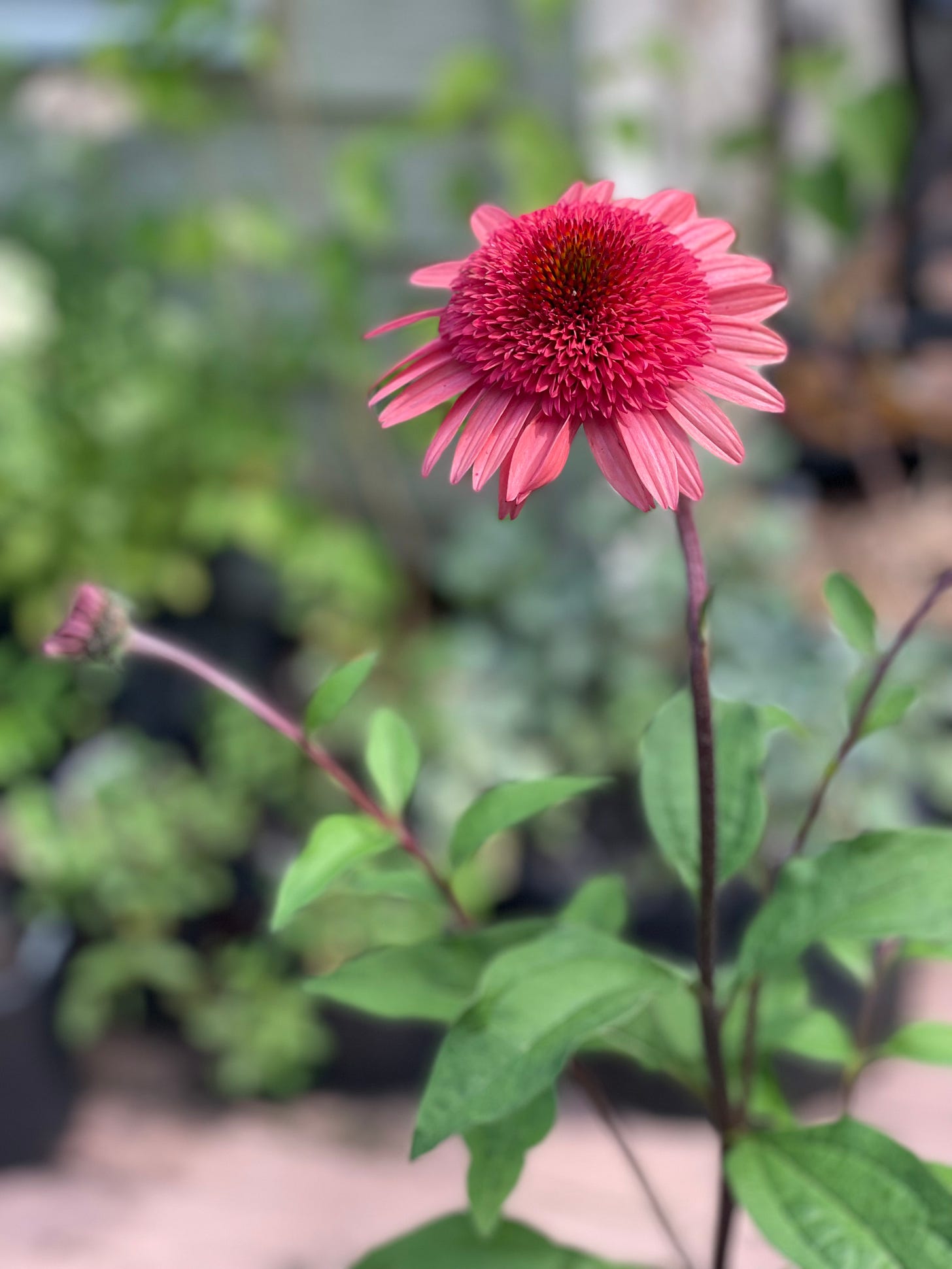
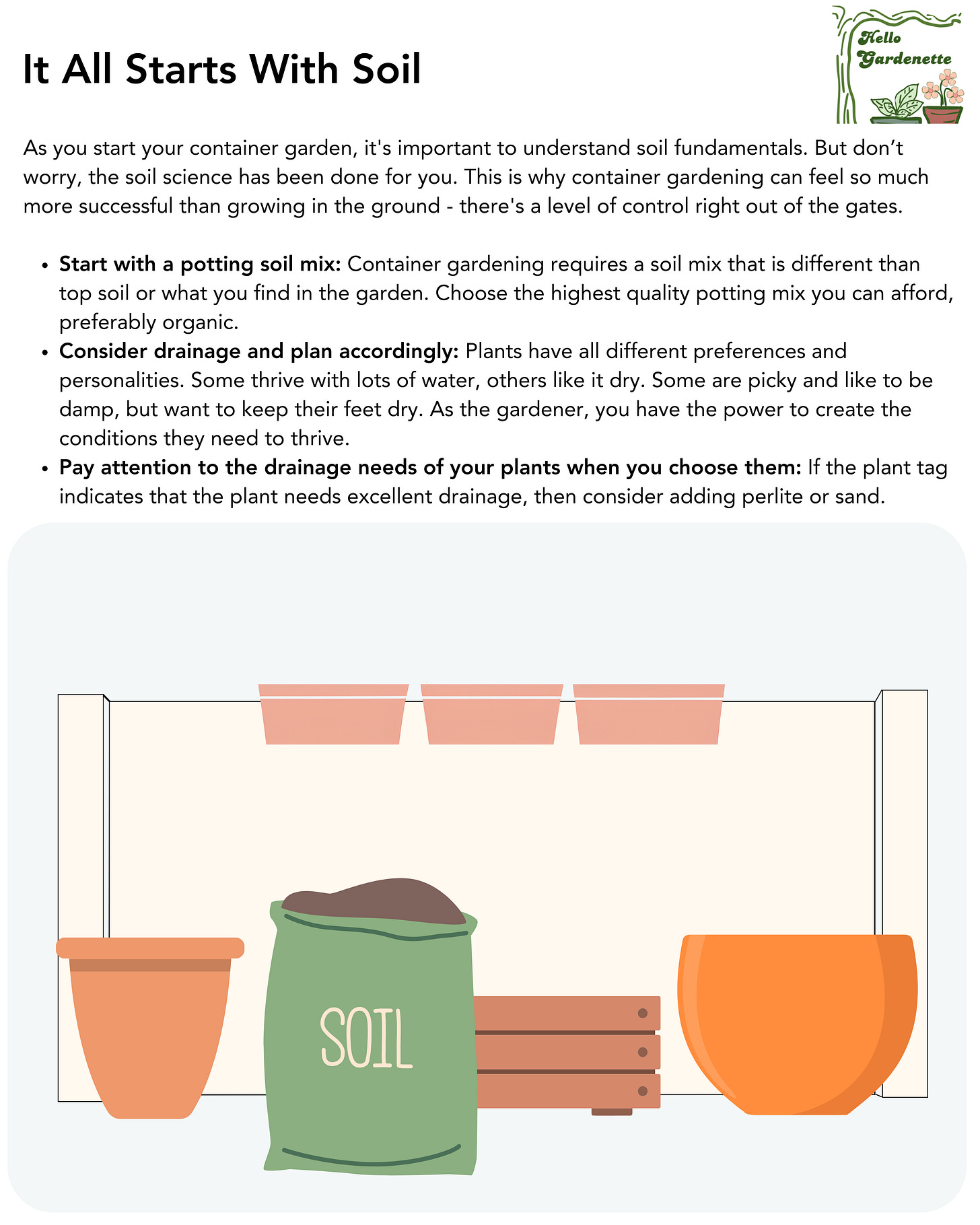
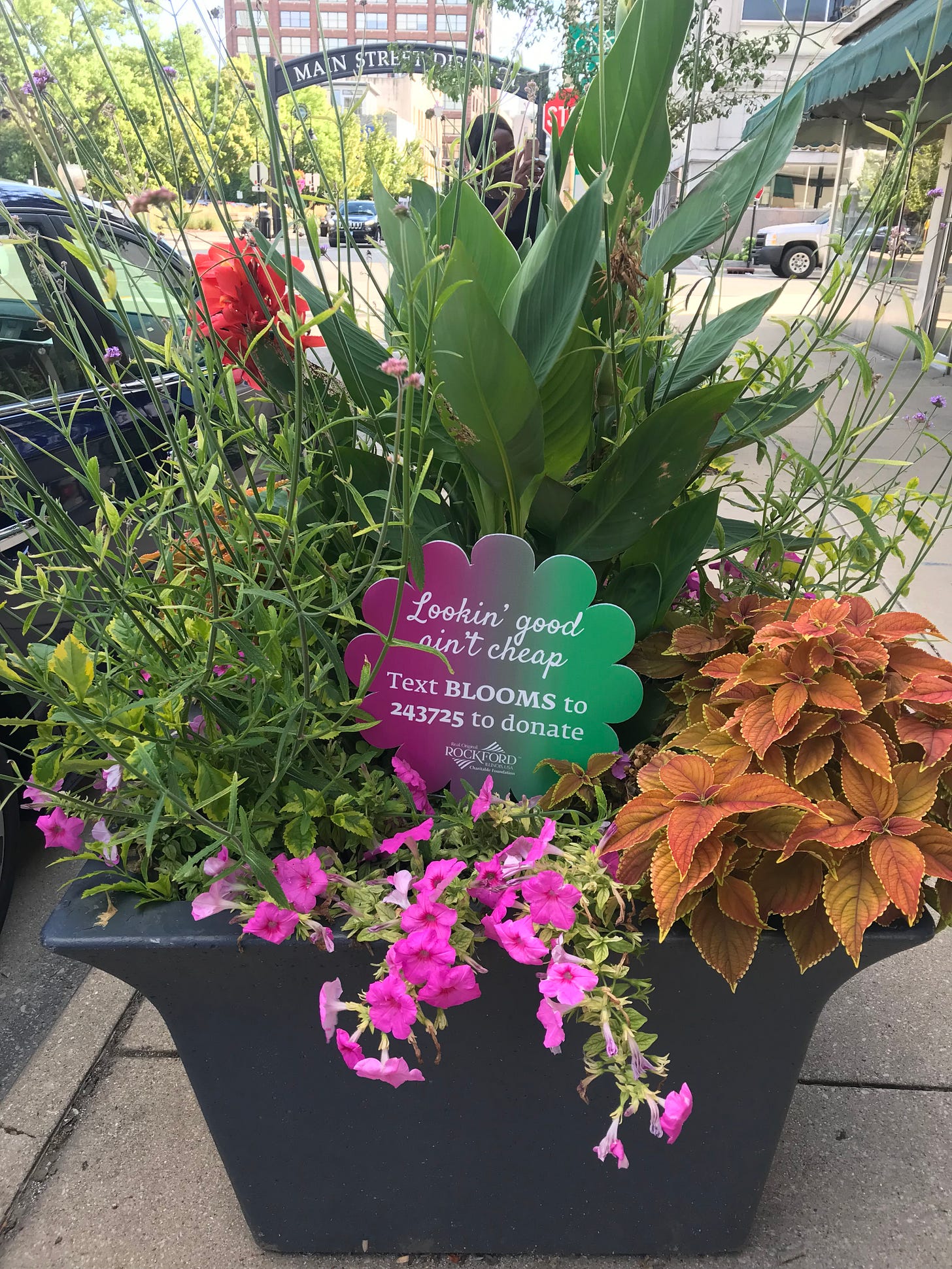


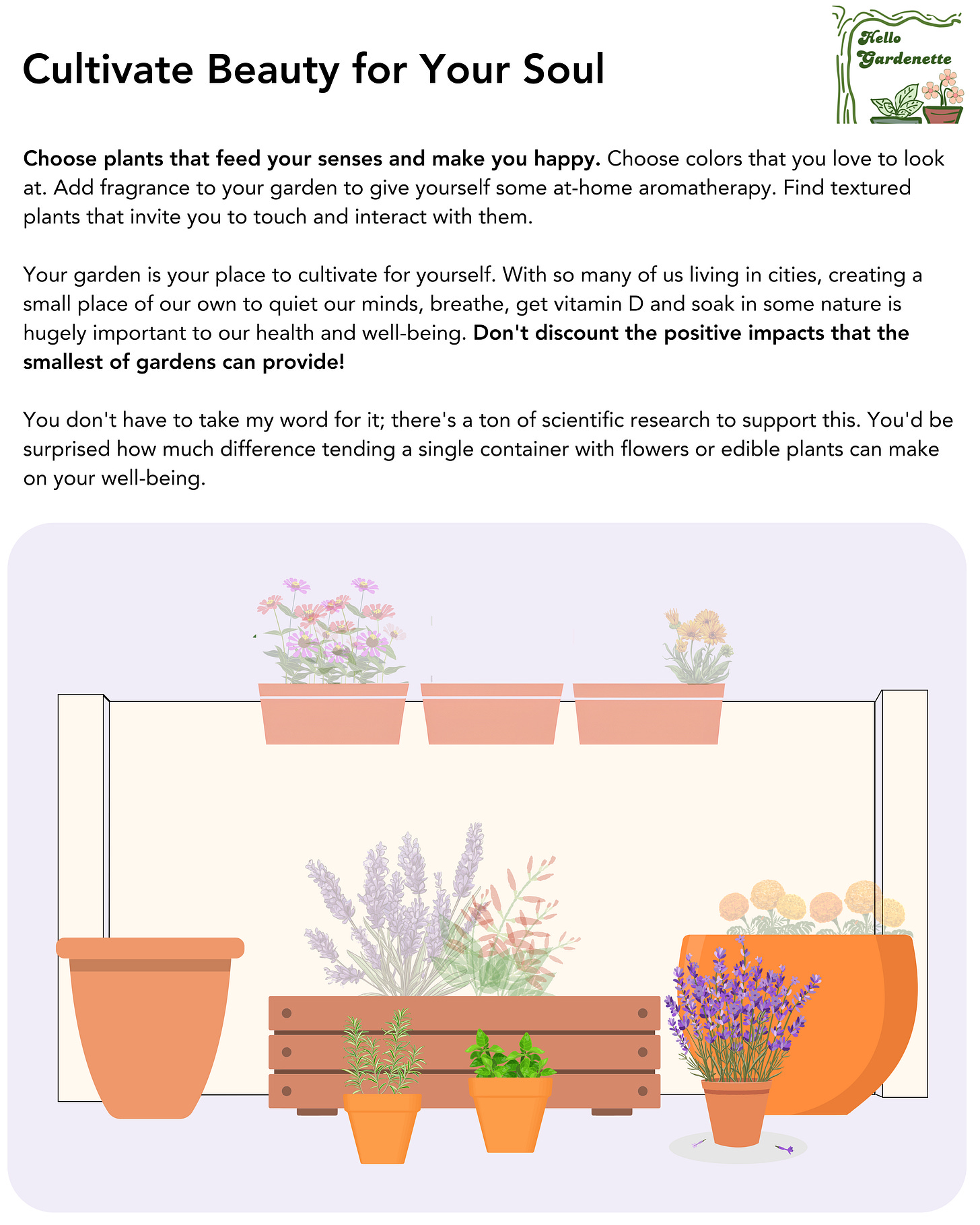
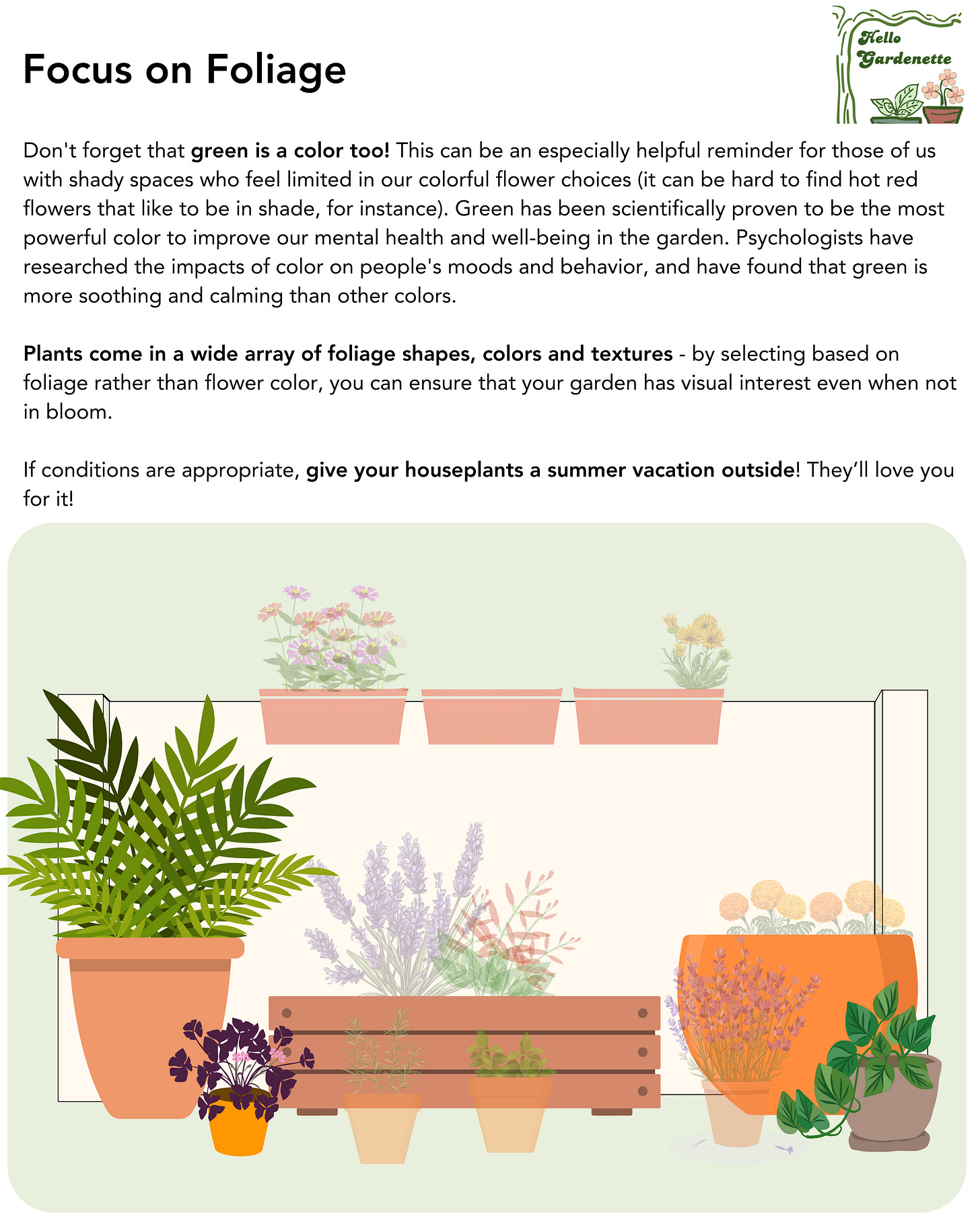
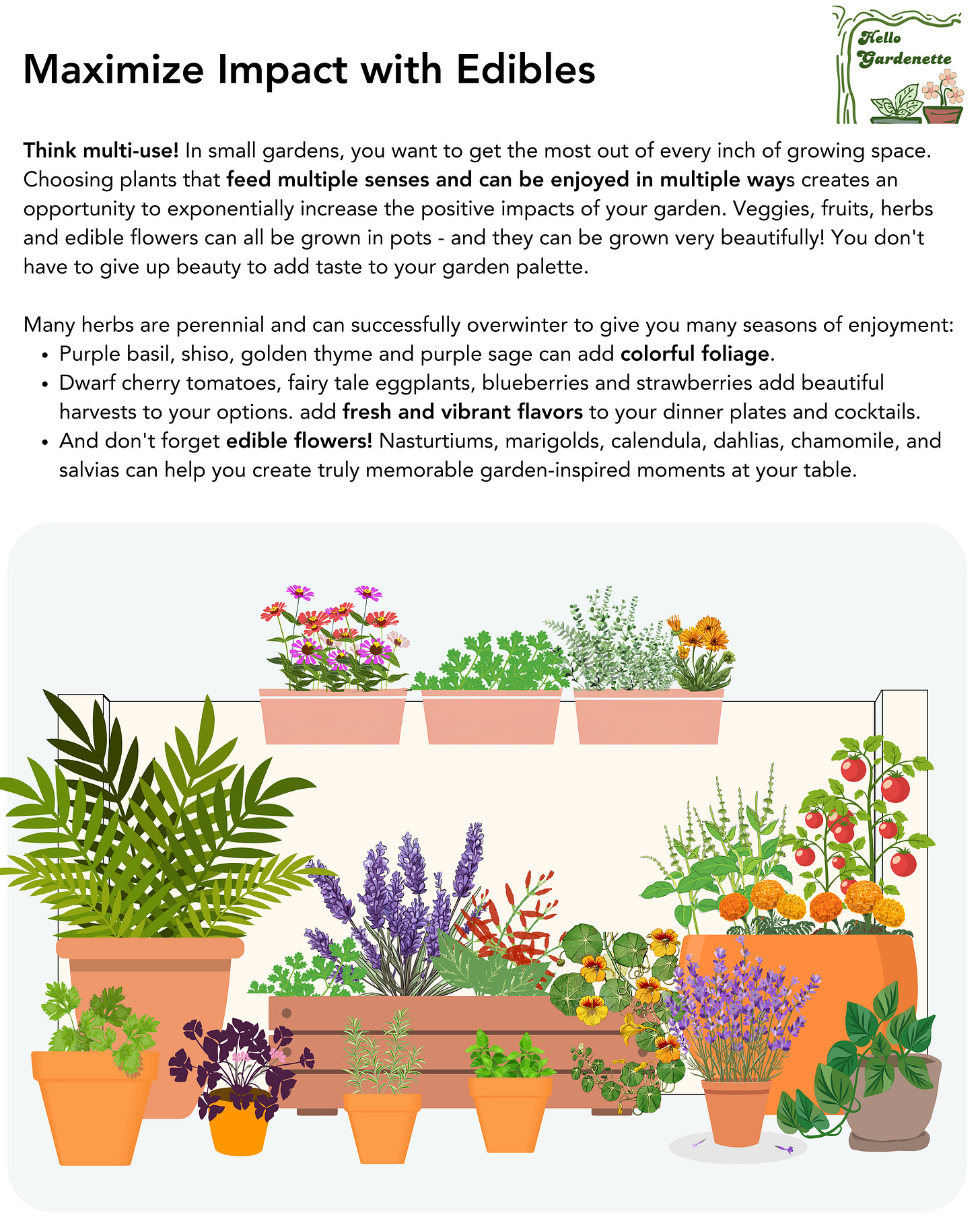
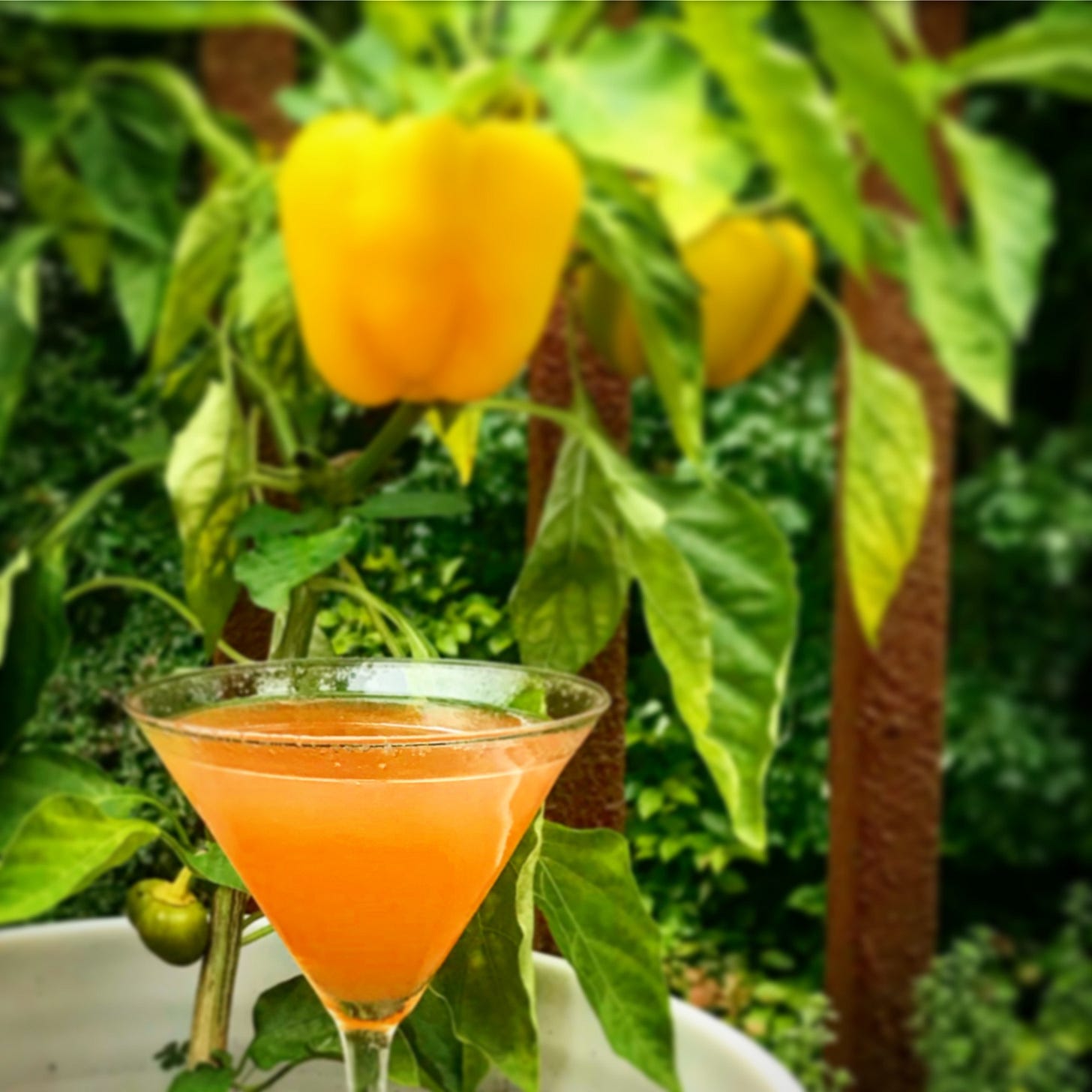
Love the illustrations! And the content is right on.
This is so well written and so important.